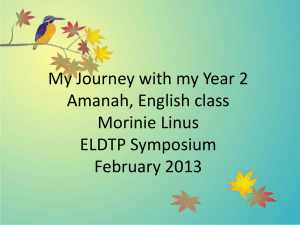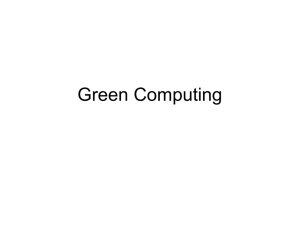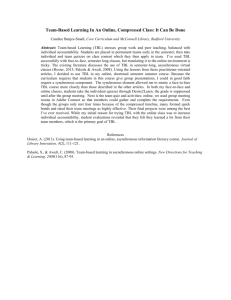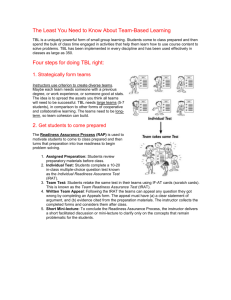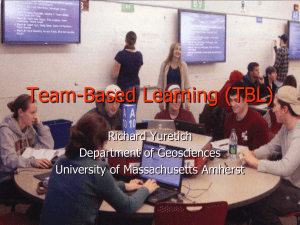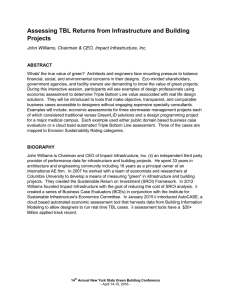Inducing Information Extraction Systems for New Languages via Cross-Language Projection
advertisement
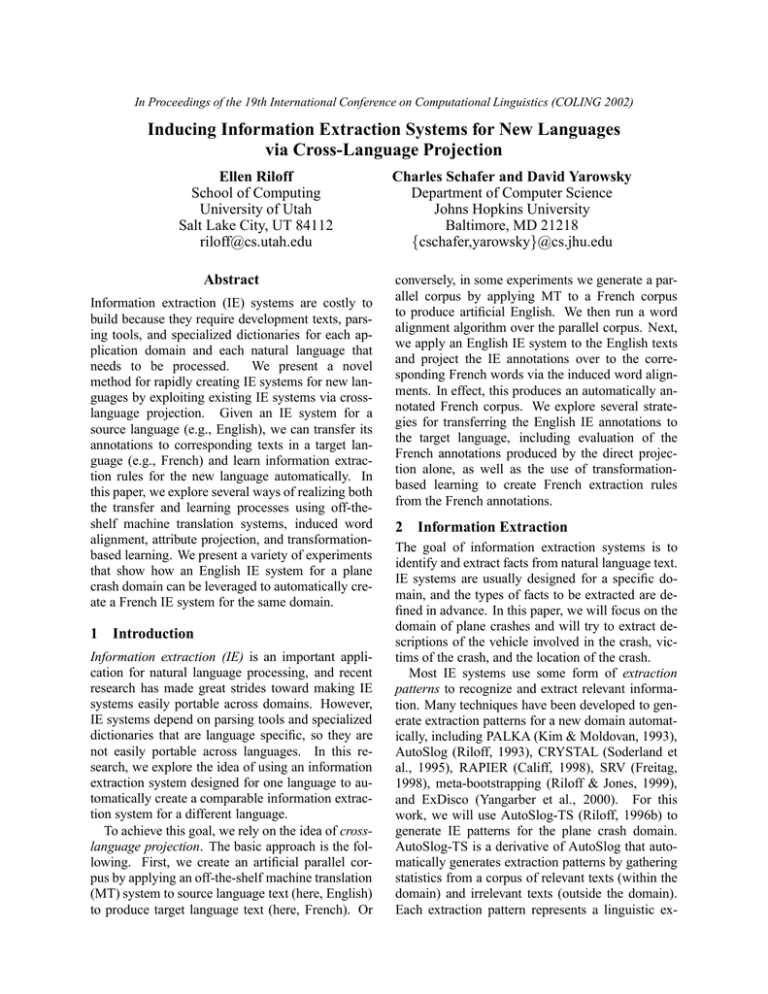
In Proceedings of the 19th International Conference on Computational Linguistics (COLING 2002)
Inducing Information Extraction Systems for New Languages
via Cross-Language Projection
Ellen Riloff
School of Computing
University of Utah
Salt Lake City, UT 84112
riloff@cs.utah.edu
Abstract
Information extraction (IE) systems are costly to
build because they require development texts, parsing tools, and specialized dictionaries for each application domain and each natural language that
needs to be processed.
We present a novel
method for rapidly creating IE systems for new languages by exploiting existing IE systems via crosslanguage projection. Given an IE system for a
source language (e.g., English), we can transfer its
annotations to corresponding texts in a target language (e.g., French) and learn information extraction rules for the new language automatically. In
this paper, we explore several ways of realizing both
the transfer and learning processes using off-theshelf machine translation systems, induced word
alignment, attribute projection, and transformationbased learning. We present a variety of experiments
that show how an English IE system for a plane
crash domain can be leveraged to automatically create a French IE system for the same domain.
1 Introduction
Information extraction (IE) is an important application for natural language processing, and recent
research has made great strides toward making IE
systems easily portable across domains. However,
IE systems depend on parsing tools and specialized
dictionaries that are language specific, so they are
not easily portable across languages. In this research, we explore the idea of using an information
extraction system designed for one language to automatically create a comparable information extraction system for a different language.
To achieve this goal, we rely on the idea of crosslanguage projection. The basic approach is the following. First, we create an artificial parallel corpus by applying an off-the-shelf machine translation
(MT) system to source language text (here, English)
to produce target language text (here, French). Or
Charles Schafer and David Yarowsky
Department of Computer Science
Johns Hopkins University
Baltimore, MD 21218
{cschafer,yarowsky}@cs.jhu.edu
conversely, in some experiments we generate a parallel corpus by applying MT to a French corpus
to produce artificial English. We then run a word
alignment algorithm over the parallel corpus. Next,
we apply an English IE system to the English texts
and project the IE annotations over to the corresponding French words via the induced word alignments. In effect, this produces an automatically annotated French corpus. We explore several strategies for transferring the English IE annotations to
the target language, including evaluation of the
French annotations produced by the direct projection alone, as well as the use of transformationbased learning to create French extraction rules
from the French annotations.
2 Information Extraction
The goal of information extraction systems is to
identify and extract facts from natural language text.
IE systems are usually designed for a specific domain, and the types of facts to be extracted are defined in advance. In this paper, we will focus on the
domain of plane crashes and will try to extract descriptions of the vehicle involved in the crash, victims of the crash, and the location of the crash.
Most IE systems use some form of extraction
patterns to recognize and extract relevant information. Many techniques have been developed to generate extraction patterns for a new domain automatically, including PALKA (Kim & Moldovan, 1993),
AutoSlog (Riloff, 1993), CRYSTAL (Soderland et
al., 1995), RAPIER (Califf, 1998), SRV (Freitag,
1998), meta-bootstrapping (Riloff & Jones, 1999),
and ExDisco (Yangarber et al., 2000). For this
work, we will use AutoSlog-TS (Riloff, 1996b) to
generate IE patterns for the plane crash domain.
AutoSlog-TS is a derivative of AutoSlog that automatically generates extraction patterns by gathering
statistics from a corpus of relevant texts (within the
domain) and irrelevant texts (outside the domain).
Each extraction pattern represents a linguistic ex-
pression that can extract noun phrases from one of
three syntactic positions: subject, direct object, or
object of a prepositional phrase. For example, the
following patterns could extract vehicles involved
in a plane crash: “<subject> crashed”, “hijacked
<direct-object>”, and “wreckage of <np>”.
We trained AutoSlog-TS using AP news stories
about plane crashes as the relevant text, and AP
news stories that do not mention plane crashes as
the irrelevant texts. AutoSlog-TS generates a list
of extraction patterns, ranked according to their association with the domain. A human must review
this list to decide which patterns are useful for the
IE task and which ones are not. We manually reviewed the top patterns and used the accepted patterns for the experiments described in this paper. To
apply the extraction patterns to new text, we used a
shallow parser called Sundance that also performs
information extraction.
3 Cross-Language Projection
3.1 Motivation and Previous Projection Work
Not all languages have received equal investment
in linguistic resources and tool development. For
a select few, resource-rich languages such as English, annotated corpora and text analysis tools are
readily available. However, for the large majority
of the world’s languages, resources such as treebanks, part-of-speech taggers, and parsers do not
exist. And even for many of the better-supported
languages, cutting edge analysis tools in areas such
as information extraction are not readily available.
One solution to this NLP-resource disparity is
to transfer linguistic resources, tools, and domain knowledge from resource-rich languages to
resource-impoverished ones. In recent years, there
has been a burst of projects based on this paradigm.
Yarowsky et al. (2001) developed cross-language
projection models for part-of-speech tags, base
noun phrases, named-entity tags, and morphological analysis (lemmatization) for four languages.
Resnik et al. (2001) developed related models for
projecting dependency parsers from English to Chinese. There has also been extensive work on the
cross-language transfer and development of ontologies and WordNets (e.g., (Atserias et al., 1997)).
3.2 Mechanics of Projection
The cross-language projection methodology employed in this paper is based on Yarowsky et al.
(2001), with one important exception. Given the
absence of available naturally occurring bilingual
A two−motor aircraft Beechcraft of the Air−Saint−Martin company
1
0
0
1
11
00
0
1
00
11
0
1
111111
000000
000
111
000000
111111
000
111
Un avion bi−moteur Beechcraft de la compagnie Air−Saint−Martin
was crushed Thursday evening in the south−east of Haiti ,
1
0
0
1
1
0
0
1
11
00
00
11
00
s’ est écrasé jeudi soir 11
dans le sud−est d’ Haiti ,
killing its 20 occupants
.
.
LOCATION
VICTIM
tuant ses 20 occupants
VEHICLE
Figure 1: French text word aligned with its English
machine translation (extractions highlighted)
corpora in our target domain, we employ commercial, off-the-shelf machine translation to generate
an artificial parallel corpus. While machine translation errors present substantial problems, MT offers
great opportunities because it frees cross-language
projection research from the relatively few large
existing bilingual corpora (such as the Canadian
Hansards). MT allows projection to be performed
on any corpus, such as the domain-specific planecrash news stories employed here. Section 5 gives
the details of the MT system and corpora that we
used.
Once the artificial parallel corpus has been created, we apply an English IE system to the English
texts and transfer the IE annotations to the target
language as follows:
1. Sentence align the parallel corpus.1
2. Word-align the parallel corpus using the
Giza++ system (Och and Ney, 2000).
3. Transfer English IE annotations and nounphrase boundaries to French via the mechanism described in Yarowsky et al. (2001),
yielding annotated sentence pairs as illustrated
in Figure 1.
4. Train a stand-alone IE tagger on these projected annotations (described in Section 4).
4 Transformation-Based Learning
We used transformation-based learning (TBL)
(Brill, 1995) to learn information extraction rules
for French. TBL is well-suited for this task because
it uses rule templates as the basis for learning, which
can be easily modeled after English extraction patterns. However, information extraction systems typically rely on a shallow parser to identify syntactic
elements (e.g., subjects and direct objects) and verb
1
This is trivial because each sentence has a numbered anchor preserved by the MT system.
Rule Condition
Rule Effect
1. w1 =crashed w2 =in
w3 is LOC .
2. w1 =wreckage w2 =of
w3 is VEH .
3. w1 =injuring
w2 is VIC .
4. w1 =NOUN w2 =crashed
w1 is VEH .
5. w1 =VERB w2 =down w3 =in
w4 is LOC .
6. w1 =φ w2 =ART w4−7 =crashed
w2 is VEH .
7. w2 =COMMA w3 =which w4 =crashed w1 is VEH .
8. w1 =in w2 =LOCATION w3 =NOUN w3 is LOC .
9. w1 =VERB w2 =VICTIM w3 =NOUN w3 is VIC .
10. w1 =ART w2 =VEHICLE
w1 is VEH .
constructions (e.g., passive vs. active voice). Our
hope was that the rules learned by TBL would be applicable to new French texts without the need for a
French parser. One of our challenges was to design
rule templates that could approximate the recognition of syntactic structures well enough to duplicate
most of the functionality of a French shallow parser.
When our TBL training begins, the initial state is
that no words are annotated. We experimented with
two sets of “truth” values: Sundance’s annotations
and human annotations. We defined 56 languageindependent rule templates, which can be broken
down into four sets designed to produce different
types of behavior. Lexical N-gram rule templates
change the annotation of a word if the word(s) immediately surrounding it exactly match the rule. We
defined rule templates for 1, 2, and 3-grams. In
Table 1, Rules 1-3 are examples of learned Lexical N-gram rules. Lexical+POS N-gram rule templates can match exact words or part-of-speech tags.
Rules 4-5 are Lexical+POS N-gram rules. Rule 5
will match verb phrases such as “went down in”,
“shot down in”, and “came down in”.
One of the most important functions of a parser is
to identify the subject of a sentence, which may be
several words away from the main verb phrase. This
is one of the trickest behaviors to duplicate without
the benefit of syntactic parsing. We designed Subject Capture rule templates to identify words that
are likely to be a syntactic subject. As an example,
Rule 6 looks for an article at the beginning of a sentence and the word “crashed” a few words ahead2 ,
and infers that the article belongs to a vehicle noun
phrase. (The NP Chaining rules described next will
extend the annotation to include the rest of the noun
phrase.) Rule 7 attempts relative pronoun disambiguation when it finds the three tokens “COMMA
which crashed” and infers that the word preceding
the comma is a vehicle.
Without the benefit of a parser, another challenge
is identifying noun phrase boundaries. We designed
NP Chaining rule templates to look at words that
have already been labelled and extend the boundaries of the annotation to cover a complete noun
phrase. As examples, Rules 8 and 9 extend location and victim annotations to the right, and Rule 10
extends a vehicle annotation to the left.
2
φ is a start-of-sentence token. w4−7 means that the item
occurs in the range of word4 through word7 .
Table 1:
Examples of Learned TBL
(LOC .=location, VEH .=vehicle, VIC .=victim)
Rules
5 Resources
The corpora used in these experiments were extracted from English and French AP news stories.
We created the corpora automatically by searching
for articles that contain plane crash keywords. The
news streams for the two languages came from different years, so the specific plane crash events described in the two corpora are disjoint. The English corpus contains roughly 420,000 words, and
the French corpus contains about 150,000 words.
For each language, we hired 3 fluent university
students to do annotation. We instructed the annotators to read each story and mark relevant entities
with SGML-style tags. Possible labels were location of a plane crash, vehicle involved in a crash,
and victim (any persons killed, injured, or surviving a crash). We asked the annotators to align their
annotations with noun phrase boundaries. The annotators marked up 1/3 of the English corpus and
about 1/2 of the French corpus.
We used a high-quality commercial machine
translation (MT) program (Systran Professional
Edition) to generate a translated parallel corpus for
each of our English and French corpora. These will
henceforth be referred to as MT-French (the Systran
translation of the English text) and MT-English (the
Systran translation of our French text).
6 Experiments and Evaluation
6.1
Scoring and Annotator Agreement
We explored two ways of measuring annotator
agreement and system performance.
(1) The
exact-word-match measure considers annotations to
match if their start and end positions are exactly the
same. (2) The exact-NP-match measure is more forgiving and considers annotations to match if they
both include the head noun of the same noun phrase.
The exact-word-match criterion is very conservative
because annotators may disagree about equally acceptable alternatives (e.g., “Boeing 727” vs. “new
Boeing 727”). Using the exact-NP-match measure,
“Boeing 727” and “new Boeing 727” would constitute a match. We used different tools to identify
noun phrases in English and French. For English,
we applied the base noun phrase chunker supplied
with the fnTBL toolkit (Ngai & Florian, 2001). In
French, we ran a part-of-speech tagger (Cucerzan
& Yarowsky, 2000) and applied regular-expression
heuristics to detect the heads of noun phrases.
We measured agreement rates among our human
annotators to assess the difficulty of the IE task. We
computed pairwise agreement scores among our 3
English annotators and among our 3 French annotators. The exact-word-match scores ranged from
16-31% for French and 24-27% for English. These
relatively low numbers suggest that the exact-wordmatch criterion is too strict. The exact-NP-match
agreement scores were much higher, ranging from
43-54% for French and 51-59% for English3 .
These agreement numbers are still relatively low,
however, which partly reflects the fact that IE is a
subjective and difficult task. Inspection of the data
revealed some systematic differences of approach
among annotators. For example, one of the French
annotators marked 4.5 times as many locations as
another. On the English side, the largest disparity
was a factor of 1.4 in the tagging of victims.
6.2
Monolingual English & French Evaluation
As a key baseline for our cross-language projection studies, we first evaluated the AutoSlog-TS
and TBL training approaches on monolingual English and French data. Figure 2 shows (1) English
training by running AutoSlog-TS on unannotated
texts and then applying its patterns to the humanannotated English test data, (2) English training and
testing by applying TBL to the human-annotated
English data with 5-fold cross-validation, (3) English training by applying TBL to annotations produced by Sundance (using AutoSlog-TS patterns)
and then testing the TBL rules on the humanannotated English data, and (4) French training and
testing by applying TBL to human annotated French
data with 5-fold cross-validation.
Table 2 shows the performance in terms of Precision (P), Recall (R) and F-measure (F). Through3
Agreement rates were computed on a subset of the data
annotated by multiple people; systems were scored against the
full corpus, of which each annotator provided the standard for
one third.
out our experiments, AutoSlog-TS training achieves
higher precision but lower recall than TBL training.
This may be due to the exhaustive coverage provided by the human annotations used by TBL, compared to the more labor-efficient but less-complete
AutoSlog-TS training that used only unannotated
data.
TS
slog−
Auto
(1)
SUNDANCE
(English)
English (plain)
S0
English TEST
280K words
140K words
[+ 280K words irrel. text]
Test TBL
L
(2)
Train TB
4/5 Eng TEST
[cross validation]
TBL (English)
1/5 Eng TEST
T0
112K words
28K words
g−TS
Autoslo
SUNDANCE
(English)
English (plain)
(3)
S1
280K words
[+ 280K words irrel. text]
Test TBL
Train TBL
TBLES
Test TBL
L
(4)
Train TB
4/5 French TEST
ES1
TS1
TBL (French)
TF0
English TEST
140K words
[cross validation]
1/5 French TEST
64K words
16K words
Figure 2: Monolingual IE Evaluation pathways4
Monolingual Training Route
English
Train AutoSlog-TS on English-plain (ASE )
Apply ASE to English Test
(2) Train TBL on 4/5 of English-Test (TBL E)
T 0: Apply TBL E to 1/5 of English Test
(perform in 5-fold cross-validation)
(3) Train AutoSlog-TS on English-plain (ASE )
S1: Apply ASE to English-plain
T S1 Train TBL on Sundance annotations
ES1: Apply TBL ES to English Test
P
R
F
(1)
S0:
.44 .42 .43
.35 .62 .45
.31 .40 .35
French
(4)
Train TBL on 4/5 of French-Test (TBL F)
T F 0: Apply TBL F to 1/5 of French Test
(perform in 5-fold cross-validation)
.47 .66 .54
Table 2: Monolingual IE Baseline Performance
6.3 TBL-based IE Projection and Induction
As noted in Section 5, both the English and French
corpora were divided into unannotated (“plain”)
and annotated (“antd” or “Tst”) sections. Figure
3 illustrates these native-language data subsets in
white. Each native-language data subset also has
a machine-translated mirror in French/English respectively (shown in black), with an identical number of sentences to the original. By word-aligning
these 4 native/MT pairs, each becomes a potential
vehicle for cross-language information projection.
Consider the pathway TE 1⇒P 1 ⇒ TF 1 as a representative example pathway for projection. Here
TE 3
English (plain)
MT−English
(plain)
English (antd)
P1
PHA 2
MT−French
(plain)
MT−English Tst
P3
P4
French (plain)
SUNDANCE
(English)
French Test
S1
English (plain)
F
Table 3 shows the results of our TBL-based experiments. The top performing pathway is the
TE 4 ⇒ P 4 two-step projection pathway shown in
Figure 3. Note the F-measure of the best pathway
is .45, which is equal to the highest F-measure for
monolingual English and only 9% lower than the Fmeasure for monolingual French.
The irrelevant texts are needed to train AutoSlog-TS, but
not TBL.
SMT 3
S MT 4
Cross−
Language
Projection
P1
S4
MT−English
(plain)
English (antd)
TBL1
Figure 3: TBL-based IE projection pathways
4
S3
TBL3
TBL2h
T 1
S2
Au
t
T F3
SUNDANCE
(MT−English)
Au
tos
THA 2
.49 .41 .45
Sundance-based IE Projection and
Induction
Figure 4 shows the projection and induction model
using Sundance for English IE annotation, which is
almost isomorphic to that using TBL. One notable
difference is that Sundance was trained by applying AutoSlog-TS to the unannotated English text
rather than the human-annotated data. Figure 4 also
shows an additional set of experiments (SM T 3 and
SM T 4) in which AutoSlog-TS was trained on the
English MT translations of the unannotated French
data. The motivation was that native-English extraction patterns tend to achieve low recall when applied
to MT-English text (given frequent mistranslations
such as “to crush” a plane rather than “to crash” a
plane). By training AutoSlog-TS on the sentences
generated by an MT system (seen in the SM T 3 and
SM T 4 pathways), the F-measure increases.5
os
French TBL
Training and
Transfer to
Test Data
.49 .34 .40
6.4
English
Annotation
MT−French
(annotated)
.56 .29 .39
Table 3: TBL-based IE projection performance
lo
Cross−
Language
Projection
TE 4
F
.69 .24 .36
−TS
HUMAN
Annotators
R
TS
TBL Training
English
TE1
Annotation
(English)
P
Apply TBL E to English-plain
Project to MT-French(English-Plain)
Train TBL & Apply to FrTest
Use human Annos from Eng Antd
Project to MT-French(English Antd)
Train TBL & Apply to FrTest
Apply TBL E to MT- E ng(FrenchPlain)
Project to French-Plain
Train TBL & Apply to FrTest
Apply TBL E to MT- E ng(FrenchTest)
Direct Project to French-Test
g−
TBL
Projection and Training Route
TE 1:
P 1:
TF 1:
–
Pha 2:
Tha 2:
TE 3:
P 3:
TF 3:
TE 4:
P 4:
log
an English TBL classifier is trained on the 140Kword human annotated data and the learned TBL
rules are applied to the unannotated English subcorpus. The annotations are then projected across
the Giza++ word alignments to their MT-French
mirror. Next, a French TBL classifier (TBL1) is
trained on the projected MT-French annotations and
the learned French TBL rules are subsequently applied to the native-French test data.
An alternative path (TE 4 ⇒ P 4 ⇒ French-Test)
is more direct, in that the English TBL classifier
is applied immediately to the word-aligned MTEnglish translation of the French test data. The MTEnglish annotations can then be directly projected
to the French test data, so no additional training
is necessary. Another short direct projection path
(PHA 2 ⇒ THA 2 ⇒ French-test) skips the need to
train an English TBL model by projecting the English human annotations directly onto MT-French
texts, which can then be used to train a French TBL
system which can be applied to the French test data.
P3
P2
MT−English Tst
PMT 3
P4
PMT 4
MT−French
(plain)
MT−French
(annotated)
French (plain)
French Test
TMT 3
French TBL
Training and
Transfer to
Test Data
T3
TBL3m
TBL3
T2
T1
TBL2
TBL1
Figure 4: Sundance-based projection pathways
5
This is a “fair” gain, in that the MT-trained AutoSlog-TS
patterns didn’t use translations of any of the French test data.
Projection and Training Route
P
R
F
AutoSlog-TS trained on native English ( ASE )
S2:
P 2:
T 2:
S(1+2):
P (1+2):
T (1+2):
S3:
P 3:
T 3:
S4:
P 4:
Apply ASE to English-Antd
Project to MT-French(English-Antd)
Train TBL FP2 & Apply to FrTest
Apply ASE to English Antd+Plain
Project to MT-French(Eng-Ant+Pl)
Train TBL FP1+2 & Apply to FrTest
Apply ASE to MT- E ng(FrenchPlain)
Project to French-Plain
Train TBL FP3 & Apply to FrTest
Apply ASE to MT- E ng(FrenchTest)
Direct Project to French-Test
.39 .24 .29
.43 .23 .30
.45 .04 .07
.48 .07 .13
AutoSlog-TS trained on MT English ( ASMTE )
SM T 3:
PM T 3:
TM T 3:
SM T 4:
PM T 4:
Apply ASMTE to MT- E ng(FrPlain)
Project to French-Plain
Train TBL FMT3 & Apply to FrTest
Apply ASMTE to MT- E ng(FrTest)
Direct Project to French-Test
.46 .25 .32
.55 .28 .37
Table 4: Sundance-based IE projection performance 6
Table 4 shows that the best Sundance pathway
achieved an F-measure of .37. Overall, Sundance
averaged 7% lower F-measures than TBL on comparable projection pathways. However, AutoSlogTS training required only 3-4 person hours to review
the learned extraction patterns while TBL training
required about 150 person-hours of manual IE annotations, so this may be a viable cost-reward tradeoff. However, the investment in manual English IE
annotations can be reused for projection to new foreign languages, so the larger time investment is a
fixed cost per-domain rather than per-language.
6.5 Analysis and Implications
• For both TBL and Sundance, the P 1, P 2 and
P 3-family of projection paths all yield stand-alone
monolingual French IE taggers not specialized for
any particular test set. In contrast, the P 4 series of
pathways (e.g. PM T 4 for Sundance), were trained
specifically on the MT output of the target test data.
Running an MT system on test data can be done automatically and requires no additional human language knowledge, but it requires additional time
(which can be substantial for MT). Thus, the higher
performance of the P 4 pathways has some cost.
• The significant performance gains shown by
Sundance when AutoSlog-TS is trained on MTEnglish rather than native-English are not free because the MT data must be generated for each new
language and/or MT system to optimally tune to
6
S(1+2) combines the training data in S1 (280K) and S2
(140K), yielding a 420K-word sample.
its peculiar language variants. No target-language
knowledge is needed in this process, however, and
reviewing AutoSlog-TS’ patterns can be done successfully by imaginative English-only speakers.
• In general, recall and F-measure drop as the
number of experimental steps increases. Averaged
over TBL and Sundance pathways, when comparing 2 and 3-step projections, mean recall decreases
from 26.8 to 21.8 (5 points), and mean F-measure
drops from 32.6 to 28.8 (3.8 points). Viable extraction patterns may simply be lost or corrupted via too
many projection and retraining phases.
• One advantage of the projection path families
of P 1 and P 2 is that no domain-specific documents
in the foreign language are required (as they are in
the P 3 family). A collection of domain-specific English texts can be used to project and induce new IE
systems even when no domain-specific documents
exist in the foreign language.
6.6
Multipath Projection
Finally, we explored the use of classifier combination to produce a premium system. We considered a
simple voting scheme over sets of individual IE systems. Every annotation of a head noun was considered a vote. We tried 4 voting combinations: (1) the
systems that used Sundance with English extraction
patterns, (2) the systems that used Sundance with
MT-English extraction patterns, (3) the systems that
used TBL trained on English human annotations,
(4) all systems. For each combination of n systems, n answer sets were produced using the voting
thresholds Tv = 1..n. For example, for Tv = 2 every annotation receiving >= 2 votes (picked by at
least 2 individual systems) was output in the answer
set. This allowed us to explore a precision/recall
tradeoff based on varying levels of consensus.
Figure 5 shows the precision/recall curves. Voting yields some improvement in F-measure and provides a way to tune the system for higher precision or higher recall by choosing the Tv threshold.
When using all English knowledge sources, the Fmeasure at Tv =1 (.48) is nearly 3% higher than the
strongest individual system. Figure 5 also shows
the performance of a 5th system (5), which is a
TBL system trained directly from the French annotations under 5-fold cross-validation. It is remarkable that the most effective voting-based projection
system from English to French comes within 6% Fmeasure of the monolingually trained system, given
that this cross-validated French monolingual system
was trained directly on data in the same language
and source as the test data. This suggests that crosslanguage projection of IE analysis capabilities can
successfully approach the performance of dedicated
systems in the target language.
1
(1) Sundance pathways
(2) Sundance−MT pathways
(3) English TBL pathways
(4) English TBL + Sundance pathways
(5) TBL Trained from French Annotations
[under 5−fold cross−validation]
0.9
0.8
domain, these additions will improve performance
not only in English but for other languages as
well. On the other hand, with minimal effort
(hours) it is possible to custom-train a system
such as Autoslog/Sundance to work relatively
well on noisy MT-English, providing a substantial
performance boost for the IE system learned for the
target language, and further gains are achieved via
voting-based classifier combination.
0.7
References
0.6
0.5
(2)
(3)
(1)
0.4
0
Precision
0.1
0.2
0.3
0.4
(4)
0.5
(5)
0.6
0.7
Recall
Figure 5: Precision/Recall curves for voting systems. Each
point represents performance for a particular voting threshold.
In all cases, precision increases and recall decreases as the
threshold is raised.
French Test-Set Performance
Multipath projection from all English resources
P R F
.43 .54 .48
Table 5: Best multipath English-French Projection Performance (from English TBL and Sundance pathways)
7 Conclusions
We have used IE systems for English to automatically derive IE systems for a second language. Even
with the quality of MT available today, our results
demonstrate that we can exploit translation tools to
transfer information extraction expertise from one
language to another. Given an IE system for a
source language, an MT system that can translate
between the source and target languages, and a word
alignment algorithm, our approach allows a user to
create a functionally comparable IE system for the
target language with very little human effort. Our
experiments demonstrated that the new IE system
can achieve roughly the same level of performance
as the source-language IE system. French and English are relatively close languages, however, so
how well these techniques will work for more distant language pairs is still an open question.
Additional performance benefits could be
achieved in two ways: (1) put more effort into
obtaining better resources for English, or (2)
implement (minor) specializations per language.
While it is expensive to advance the state of the art
in English IE or to buy annotated data for a new
J. Atserias, S. Climent, X. Farreres, G. Rigau and H. Rodriguez.
1997. Combining multiple methods for the automatic construction of multilingual WordNets. In Proceedings of the
International Conference on Recent Advances in Natural
Language Processing.
E. Brill. 1995. Transformation-based error-driven learning and
natural language processing: A case study in part of speech
tagging. Computational Linguistics, 21(4):543–565.
M. E. Califf. 1998. Relational learning techniques for natural
language information extraction. Ph.D. thesis, Tech. Rept.
AI98-276, Artificial Intelligence Laboratory, The University
of Texas at Austin.
S. Cucerzan and D. Yarowsky. 2000. Language independent
minimally supervised induction of lexical probabilities. In
Proceedings of ACL-2000, pages 270-277.
D. Freitag. 1998. Toward general-purpose learning for information extraction. In Proceedings of COLING-ACL’98,
pages 404-408.
J. Kim and D. Moldovan. 1993. Acquisition of semantic patterns for information extraction from corpora. In Proceedings of the Ninth IEEE Conference on Artificial Intelligence
for Applications, pages 171–176.
G. Ngai and R. Florian. 2001. Transformation-based learning
in the fast lane. In Proceedings of NAACL, pages 40-47.
F. J. Och and H. Ney. 2000. Improved statistical alignment
models. In Proceedings of the 38th Annual Meeting of the
Association for Computational Linguistics, pages 440–447.
E. Riloff. 1993. Automatically Constructing a dictionary for
information extraction tasks. In Proceedings of the Eleventh
National Conference on Artificial Intelligence, pages 811–
816.
E. Riloff. 1996b. Automatically generating extraction patterns
from untagged text. In Proceedings of the Thirteenth National Conference on Artificial Intelligence, pages 1044–
1049. AAAI Press/MIT Press.
E. Riloff and R. Jones. 1999. Learning dictionaries for information extraction by multi-level bootstrapping. In Proceedings of the Sixteenth National Conference on Artificial Intelligence, pages 474–479.
S. Soderland, D. Fisher, J. Aseltine, and W. Lehnert. 1995.
CRYSTAL: Inducing a conceptual dictionary. In Proceedings of the Fourteenth International Joint Conference on Artificial Intelligence, pages 1314–1319.
R. Yangarber, R. Grishman, P. Tapanainen, and S. Huttunen.
2000. Automatic acquisiton of domain knowledge for information extraction. In Proceedings of COLING-2000, pages
940-946.
Yarowsky, D., G. Ngai and R. Wicentowski. 2001. Inducing
multilingual text analysis tools via robust projection across
aligned corpora. In Proceedings of HLT-01, pages 161–168.
